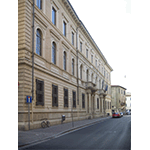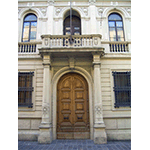Biblioteca Universitaria di Pisa - Palazzo della Sapienza [University Library of Pisa - Palazzo della Sapienza]
The University Library of Pisa was opened to the public in 1742 on the premises of Via Santa Maria close to the Astronomical Observatory. The initial holding, mostly formed by the private library of jurist Giuseppe Averani, was enriched thanks to accessions in 1757 of the library of scholar Anton Francesco Gori (about 6000 volumes) and, in 1771, by order of Grand Duke Peter Leopold of Lorraine, of many duplicate copies of volumes of the Medici-Palatine-Lotharingian Library. In 1783, the University Library received the rich book patrimony of the Camaldolese monastery of San Michele in Borgo, enriched by mathematician Father Guido Grandi. The manuscripts that belonged to Grandi form the most important part of the holding, with writings on hydraulics, mathematics, physics, and mechanics. Particularly interesting is the collection of letters which comprises some 4000 letters between the Pisan mathematician and illustrious correspondents, such as Alessandro Marchetti, Antonio Magliabechi, Eustachio Manfredi and Antonio Vallisneri.
Moved to Palazzo della Sapienza in 1823, the Library recorded yet another significant enlargement under the direction of astronomer Giuseppe Piazzini. Part of the remarkable patrimony is formed by letters of Galileo Galilei and other illustrious scientists of the Pisan university, in addition to memorabilia and the holding of the old Botanical Garden. Also worthy of mention is the important holding of manuscripts of Egyptologist Ippolito Rosellini who was also director of the Pisan Library from 1835 to 1843.
The Sapienza welcomed the scientists who convened during the First Congress of Italian Scientists (1839), desired by Luciano Bonaparte and supported by Grand Duke Leopold II. This occasion witnessed the inauguration of the statue of Galileo Galilei, sculpted by Paolo Emilio Demi, and today conserved in the historical Great Hall. Among Galilean memorabilia, let us cite a nineteenth-century plaster bust portraying Galileo, and a painting by Antonio Caimi (1946) with the Pisan scientist in the act of presenting the telescope to the Senate of Venice, presented to the University Library by Prefect Luigi Torelli on the occasion of the third centennial of the birth of Galileo, which took place in Pisa in February 1864.
****************************
Texts by Alessandro Tosi
English translation by Victor Beard
Last update 01/feb/2008





